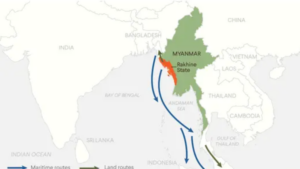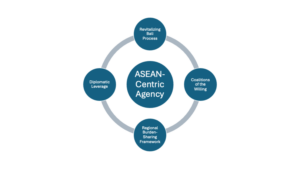Can ASEAN Chart Strategic Clarity on the Rohingya Andaman Sea Refugee?
The crisis of Rohingya boat people in the Andaman Sea and Bay of Bengal has been a starkly , particularly given that the national unity government of Myanmar is immune to membership sanctions for forcibly enacting systematic killing against the Rohingya minority and dethroning undemocratically a legitimate government led by democratic icon, Aung San Suu Kyi, through a coup d’état. Myanmar’s “immunity” from sanctions needs to be contextualised within ASEAN’s consensus-based decision-making. In contrast, leaving the crisis unmitigated and unmanaged has led to a disruptive environment in ASEAN host countries – Indonesia, Malaysia, and Thailand – which simultaneously exhibit a fracture in their geopolitical imaginaries in the Indo-Pacific.
Mapping Peril in the Indo-Pacific

The term ‘Rohingya boat people’ became a popular soundbite following their irregular migration en masse in the Andaman Sea to seek safety from violence in Rakhine state (Myanmar) and Cox’s Bazar (Bangladesh). These are due to three key drivers. First, overcrowding and severe aid restrictions in Coz Bazaar have been a powerful push factor that led to a life-threatening situation. Second, the failure of the repatriation policy amid insecurity and the citizenship issue, coupled with limited options for a durable third-country resettlement. Third, the Andaman Sea exhibits a web of predatory networks that have exploited refugees in a cycle of smuggling and trafficking.
Distribution and Routes: A Data-Driven View

Figure 1 UNHCR Report for July 2025
The UNHCR reported that over 3,500 refugees attempted a sea journey in 2023 alone. The data shown above estimated that approximately 1 in 8 refugees perished at sea during the first half of 2025. While their primary departure points are Cox’s Bazaar and Rakhine State, their major arrival points are Indonesia (Aceh Province), Malaysia (Langkawi and Penang), and Thailand (southern coast).
ASEAN Normative and Institutional Limitations
The principle of ‘non-interference’ embodied in the ASEAN Charter (Article 2) has been widely perceived as a major stumbling block for progressing a virtually durable solution. In addition to the absence of ‘intervening power’, the principle has been weaponised by Myanmar’s national unity government to avoid accountability by contending that the issue is the ‘internal affairs’ that should not be intervened in by other ASEAN member-states (Iannone et al., 2024, pp. 67–69). The ASEAN Point Consensus (FPC) remains central as a principal framework of response despite a lack of actionable pathways to resolution, as mirrored in the extreme paralysis at the enforcement level. The handicapped FPC has become another episode of continuous normative liability within ASEAN, as it leads to the normalisation of political violence, making the prospect for peaceful settlement nearly impossible (Alexandra & Adhikari, 2023, pp. 2–3). Indonesia’s chairmanship in 2023 faced a diplomatic hurdle as the FPC became somewhat of a ‘unilateral initiative’ as it lacks collective receptions from the regional blocs, particularly from the next rotational chairs, Laos (2024) and Malaysia (2025), despite the latter performing constructively in the recent Cambodia and Thailand border skirmish. Consensus in ASEAN requires unanimity in decision-making, which effectively grants the Myanmar government immunity and veto power to intercept any coordinated maritime response (Quint, 2023, pp. 37–42).
The current ASEAN Chair, Prime Minister Anwar Ibrahim, convened an ‘emergency peace talk’ in Kuala Lumpur that has put an immediate ceasefire between Cambodia and Thailand, thanks to the US and China’s brokerage. This means that the ASEAN normative framework still has leverage at bilateral and minilateral levels to draw on multiple channels of communications to forge a tangible outcome despite fragmentation at the regional level. Furthermore, the ASEAN Sectoral Body in charge of human rights – the ASEAN Intergovernmental Commission on Human Rights (AICHR) needs to carry a stronger functional mandate beyond promotion and prevention, but also to deliver or at least coordinate protection among sovereign actors for Andaman Sea refugees (Alchatib, 2022, pp. 72–73). Ten years since the adoption of the Kuala Lumpur Declaration on Irregular Movement of Persons in Southeast Asia, ASEAN Senior Official Meetings (SOM) and related meetings still fall short in adding a refugee dimension to the ASEAN institutional framework. The protection mandate will grant AICHR a coordinating power to work on a regional asylum framework to address the Andaman Sea crisis comprehensively, from displacement to statelessness, and more importantly, the root cause of systematic persecution.
Charting Pathways for Strategic Clarity: An ASEAN-Centric Course
In this article, I argue that strategic clarity is feasible by building institutional credibility in shaping ASEAN agency to address regional crises. This needs a host of practical mitigation steps that align with ASEAN core structures, thereby preserving its centrality as follows:
-
Drawing a Practical Plan of Action through the Bali Process
The Regional Support Office (RSO) Bali Process – co-chaired by the Government of Indonesia and Australia, which traditionally facilitates cooperation on irregular migration in the Asia Pacific region, can transform from a track 1.5 working group into an intergovernmental hub (Abraham, 2025, pp. 47–49). This hub performs intelligence sharing to track routes of people smuggling, coordinate joint maritime patrol, and promote stakeholder capacity building primarily from the sites of origin, primarily Cox Bazaar and Rakhine State, the Southeast Asian countries of destination (Malaysia, Indonesia, and Thailand), and even the third countries of destinations (Australia, India, and Pakistan)
-
Engage Bangladesh through the ‘ASEAN Minus Formula’ in Southeast Asia
Front-line states – Indonesia, Malaysia, and Thailand need to form a sizable coalition to work with Bangladesh on measurable humanitarian efforts, including influx screening, economic burden-sharing, and temporary protection to build trust and reduce diplomatic disruption. This sub-group formation represents the ASEAN minus formula to enable the regional bloc to draw strategic clarity without full consensus (Ng, 2021). This formula is only applicable in agreed ‘niche areas’ to empower the ASEAN chair to conduct shuttle diplomacy and fact-finding without agreements from all member-states.
-
Socialise Burden-Sharing Framework
Through ASEAN dialogue and development partnerships channels – including ASEAN Plus Six (APS), third-party countries that acceded to ASEAN principles (Australia, China, India, South Korea, New Zealand, and Japan) can be engaged by front-line states to expand third-country resettlement quotas through a burden-sharing framework (Urata, 2008, pp. 1–3). This can encompass financial support and technical assistance linked to the implementation of the Bali Process. This could minimise the potential for hazardous detentions and pushbacks, ensuring stronger adherence to the refugee statute in the region.
-
Create Diplomatic Leverage through Citizenship Restoration Campaign
Diplomatic pressure on Myanmar’s national unity government has significantly loosened recently, following ASEAN’s reluctance to impose sanctions on Myanmar’s membership, coupled with silent diplomacy from front-line states and ASEAN Sectoral Bodies through solely constructive paths without deterrence, which gave incentives to the Myanmar government to ‘lowball’ on citizenship rights. In a recorded platform, Indonesia’s leading analyst, Dewi Fortuna Anwar, aimed point-blank at ASEAN leadership: “If it were me, Myanmar’s membership would be suspended effective immediately.” Her insistence called for a glaring violation of the ASEAN charter following a) mass killing and b) systematic coup d’état, making the presence of the Myanmar leadership on the ASEAN negotiating table illegitimate. Thus, the ideal leverage for Myanmar to normalise its presence in ASEAN, among other things, is by reinstating citizenship rights to Rohingya returnees to halt regional disruption at sea.
Frame burden-sharing as a stabilising mechanism aligned with ASEAN’s principles of regional solidarity and non-interference.
- Encourage member states to adopt differentiated responsibilities based on capacity, geography, and political will—e.g., Malaysia and Indonesia for reception, Thailand for transit, and Singapore for technical support.
- Integrate humanitarian corridors and maritime protection protocols into existing ASEAN disaster response frameworks (e.g., AHA Centre).

The Rohingya Andaman Sea crisis is not a simple snapshot of humanitarian tragedy in the Indian Ocean. It is a part of a grand consequence of systematic impunity, entitled to a sovereign actor complicit against the rule of law at the global and regional levels. It directly violates the ‘non-refoulement principle’ within the UN Convention Related to the Status of Refugees, and more importantly, the ‘non-constitutional change of government’ within the ASEAN charter. The absence of an enforcement mechanism is the main design flaw of the ASEAN institutions. ASEAN should move forward constructively with strategic clarity – engaging not just the national unity government of Myanmar but also ethnic groups and civil societies to inform policy intervention, thus shaping a more robust agency on the ground. The presence of the ASEAN envoy to Myanmar – not just a rotational envoy delegated by the rotating ASEAN chair, as alluded to by Professor Dewi Fortuna Anwar – could be a significant breakthrough in comprehensively addressing the Myanmar crisis. A recalibration of ASEAN’s Indo-Pacific Vision—one that integrates human security, refugee protection, and maritime governance—is urgently needed to prevent further erosion of regional solidarity and legitimacy. Embracing an inclusive but pragmatic path through strategic coalitions, maximising the outcome of the Bali Process, enacting a burden-sharing framework, and creating diplomatic leverage through multiple channels can manifest a strategic clarity needed to mitigate the crisis, thus emboldening the normative capacity of the ‘ASEAN Way’ as a strategic imperative in the Indo-Pacific.
Bibliography
- Abraham, I. (2025). The Limits of Refugee Protection in Urban Southeast Asia. In S. Kneebone, R. Marinas, Missbach Antje, & M. Walden (Eds.), Refugee Protection in Southeast Asia: Between Humanitarianism and Sovereignty (Vol. 51, pp. 1–50). Bergham Books. https://doi.org/10.3167/9781805397809
- Alchatib, S. R. (2022). Reinventing the regional humanitarian order responses to the Rohingya refugee crisis from the UNHCR, ASEAN and South Asia. In Marginalisation and Human Rights in Southeast Asia (pp. 67–83). Taylor and Francis. https://doi.org/10.4324/9781003331858-6
- Alexandra, L., & Adhikari, M. (2023). The role of ASEAN in Myanmar’s post-coup crisis: Breaking the stalemate? https://www.instagram.com/peace_rep_/
- Iannone, A., Konchanan, V., & Wiryawan, B. (2024). Regional Integration and The Myanmar Crisis: Navigating The Delicate Balance Between Human Rights and Non-Interference Policy In ASEAN. Jurnal Ilmu Sosial, 23(1), 64–79. https://doi.org/http://dx.doi.org/10.14710/jis.23.1.2024.64-79
- Ng, J. (2021). Extending the ‘ASEAN Minus X’ Formula. In Contesting Sovereignty (pp. 224–252). Cambridge University Press. https://doi.org/10.1017/9781108854320.012
- Quint, K. (2023). ASEAN’s Approach to the Responsibility to Protect: Case Analysis of the Rohingya in Myanmar [Europa-Universität Viadrina Frankfurt]. https://doi.org/10.13140/RG.2.2.10871.60328
- Urata, S. (2008). An ASEAN+6 Economic Partnership: Significance and Tasks. http://www.jcer.or.jp/



